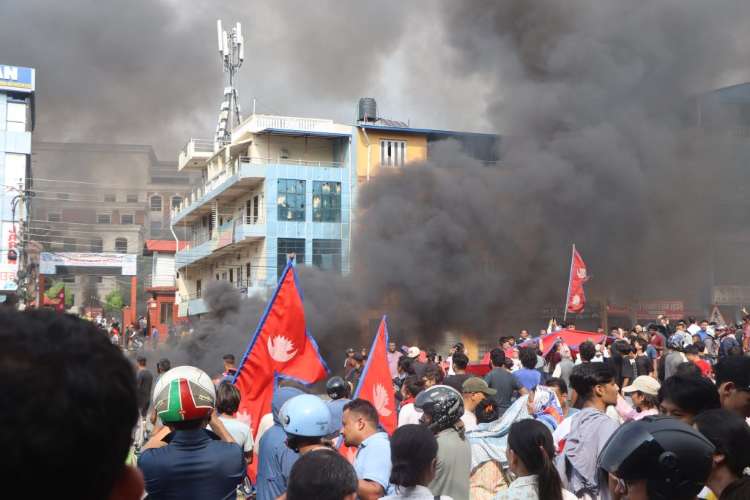Following the sudden outbreak of mass protests that forced Nepal Prime Minister K.P.Sharma Oli to resign on September 9 and vanish from public sight, the Nepal Army is now the main actor determining the future of the country.
As protests broke out and escalated rapidly, the Nepal Army was a mute witness to the burning down of government buildings and property. In Kathmandu, the Army Headquarters was hardly 500 metres away from scenes of arson. Indeed, one Nepal Army platoon was inside the Singha Durbar parliament complex to protect the Secretariat and the Supreme Court located within the complex. The parliament, the secretariat housing ministers’ offices, and the court were all burnt down by mobs.
READ | GST reforms unfinished without input tax credit fix
The Chief of Army Staff has initiated a dialogue with the leaders of the protestors including populist leader Balen Shah who is the Mayor of the Kathmandu Metropolitan city. In addition, sections of the media have floated the name of former Chief Justice of Nepal Sushila Karki as potential head of an interim government.
Historically, Nepal Army has never been a proactive player in Nepal politics and has never attempted to take over power. Its current position is reminiscent of the role played by the Bangladesh Army following the sudden protests there that forced former Prime Minister Sheikh Hasina to flee to India.
From peaceful marches to violent uprising
The protestors, on their part, also seemed to be inspired by similar movements in Sri Lanka and Bangladesh. In both countries, protesters stormed the houses of political leaders, and subsequently demanded that a non-political person should lead the country after ousting the elected government.
The Gen-Z protest in Nepal started on September 8, 2025, and quickly transformed itself into violence and vandalism. Youngsters had started with peaceful protests demanding the lifting of a ban on social media as well as an end to rampant corruption and political mismanagement in the country.
A total of 22 people lost their lives during the protest and 256 people sustained injuries. The government, non-existent at the time of writing, needs an independent commission to investigate the killings and the injuries caused during the protest.
The protests cost Prime Minister Oli his job as on the first day of protests itself he faced unprecedented pressure from his coalition partners in the Nepali Congress and his own party, the Communist Party of Nepal (Unified Marxist-Leninist) (CPN-UML). He resigned a day later, unable to bring the protests under control.
After his resignation began an unprecedented spree of vandalism and looting.
Apart from arson attacks targeting parliament, the Supreme Court, and other symbols of state power, there was also violence against individuals. Gangs of protestors targeted leaders from the Nepali Congress, CPN-UML and Communist Party of Nepal (Maoist Centre), all part of the ruling coalition.
In addition, the party offices of these parties were set on fire. Certain business houses and media personnel also faced attacks. On September 10, so-called Gen-Z gangs started to break into prisons all over Nepal, releasing those incarcerated there.
The protest expanded to all the major cities of Nepal like Pokhara, Biratnagar, and Bhairahawa. There too the buildings housing offices of the provincial and local government were targeted. Despite a curfew being imposed the protestors continued to attack regional political leaders and their homes.
Nepal Army steps into the political vacuum
Nepal is now faced with a paradoxical situation – the political parties still want the Constitution to be functional but the youth have got rid of the Central as well as the provincial governments by force. The provincial governments and the inclusive, secular and federal Constitution were designed to empower the marginalised and the poor in Nepal. It seems all those goals have been thrown out of the window or consigned to the flames.
Undermining the Constitution of 2015 – indeed virtually scrapping it – lends a greater uncertainty and volatility to the situation in Nepal.
The political parties are the major stakeholders of the democratic process in Nepal. They had struggled to overthrow the autocracy of King Gyanendra Shah in 2008 and the Rana regime in 1951. Despite their shortcomings and allegations of corruption and administrative malpractices, the political parties have developed a political culture.
It was because of this culture of dialogue and reconciliation that the political parties were able to do the unthinkable — end a ten-year-long armed insurgency of Maoists in Nepal in 2006 and bring them on the path of multiparty democracy.
It is significant that the parliamentary political parties were not invited and engaged in the dialogue process now in motion with the backing of the army. As the Nepal Parliament has not as yet been dissolved, this seems aimed at weakening the role of the political parties. If the parties are not included in the dialogue process, it may lead to further instability in the near future.
While it is important for the army and police to restore and maintain peace in the country at this critical time, they – and all of Nepal’s neighbours and well-wishers – also need to protect the democratic constitution of the country and follow its mandate.
Som Niroula is a research scholar at the Department of Conflict, Peace and Development, Tribhuvan University, Kathmandu, Nepal. Originally published under Creative Commons by 360info

